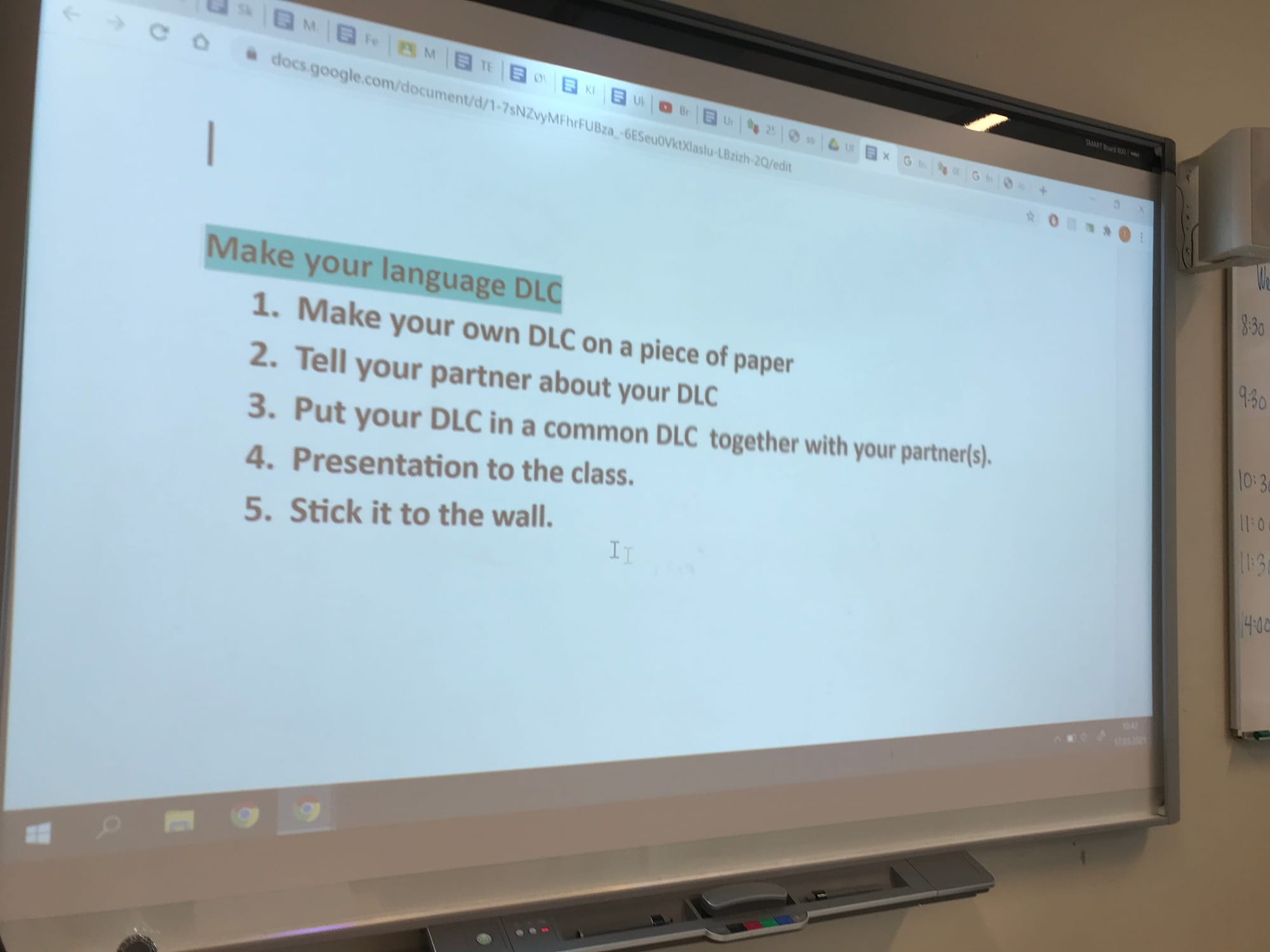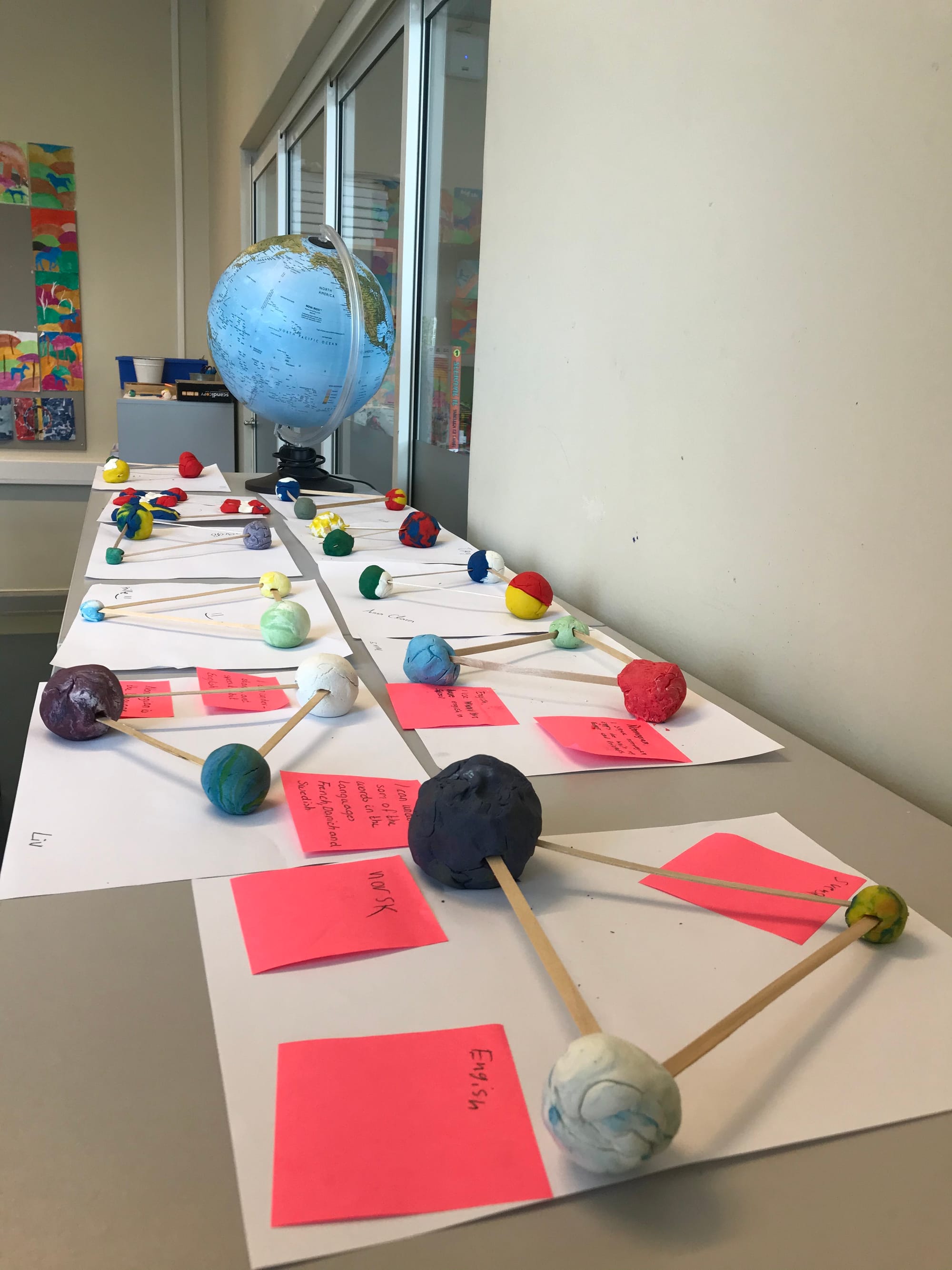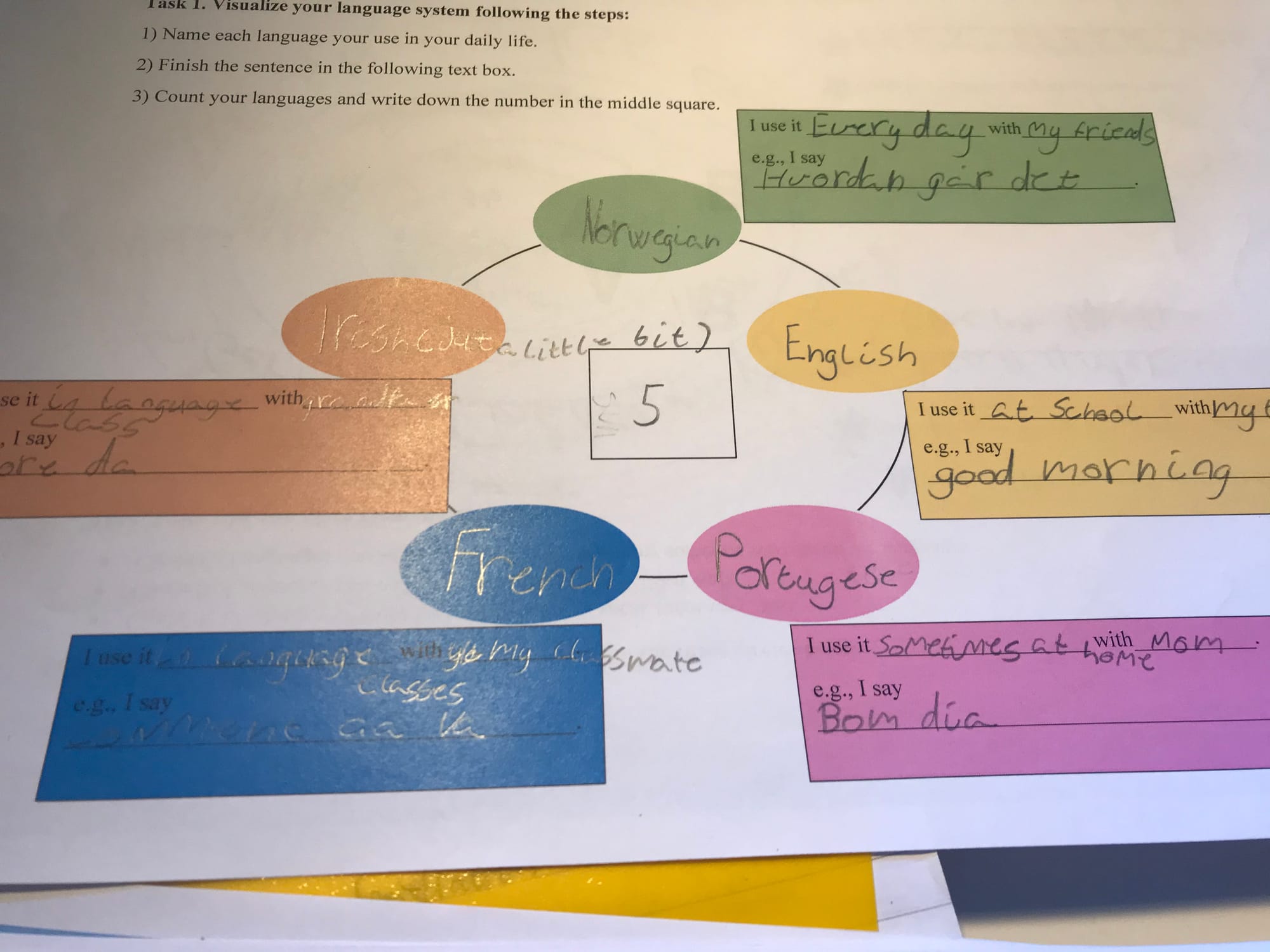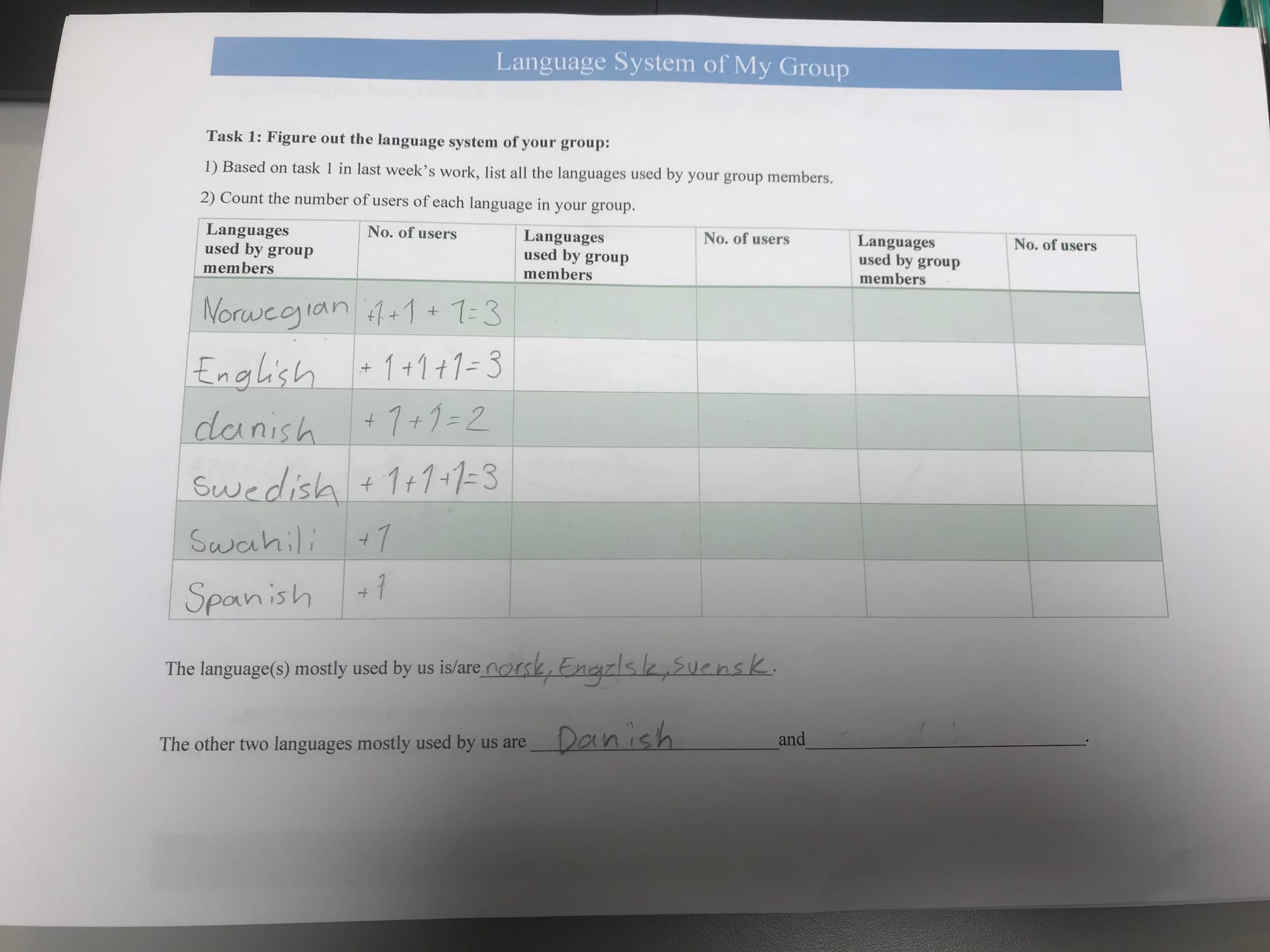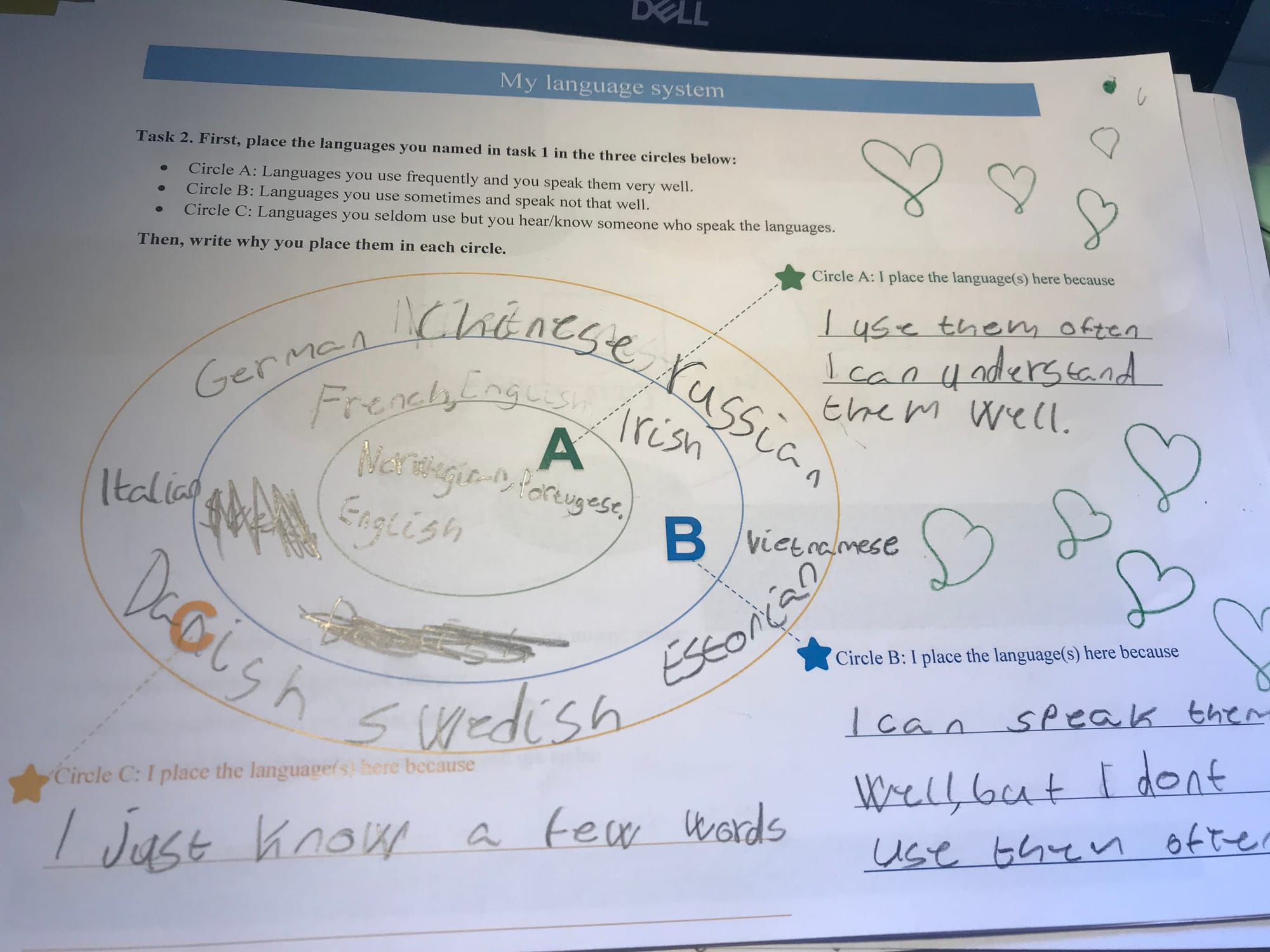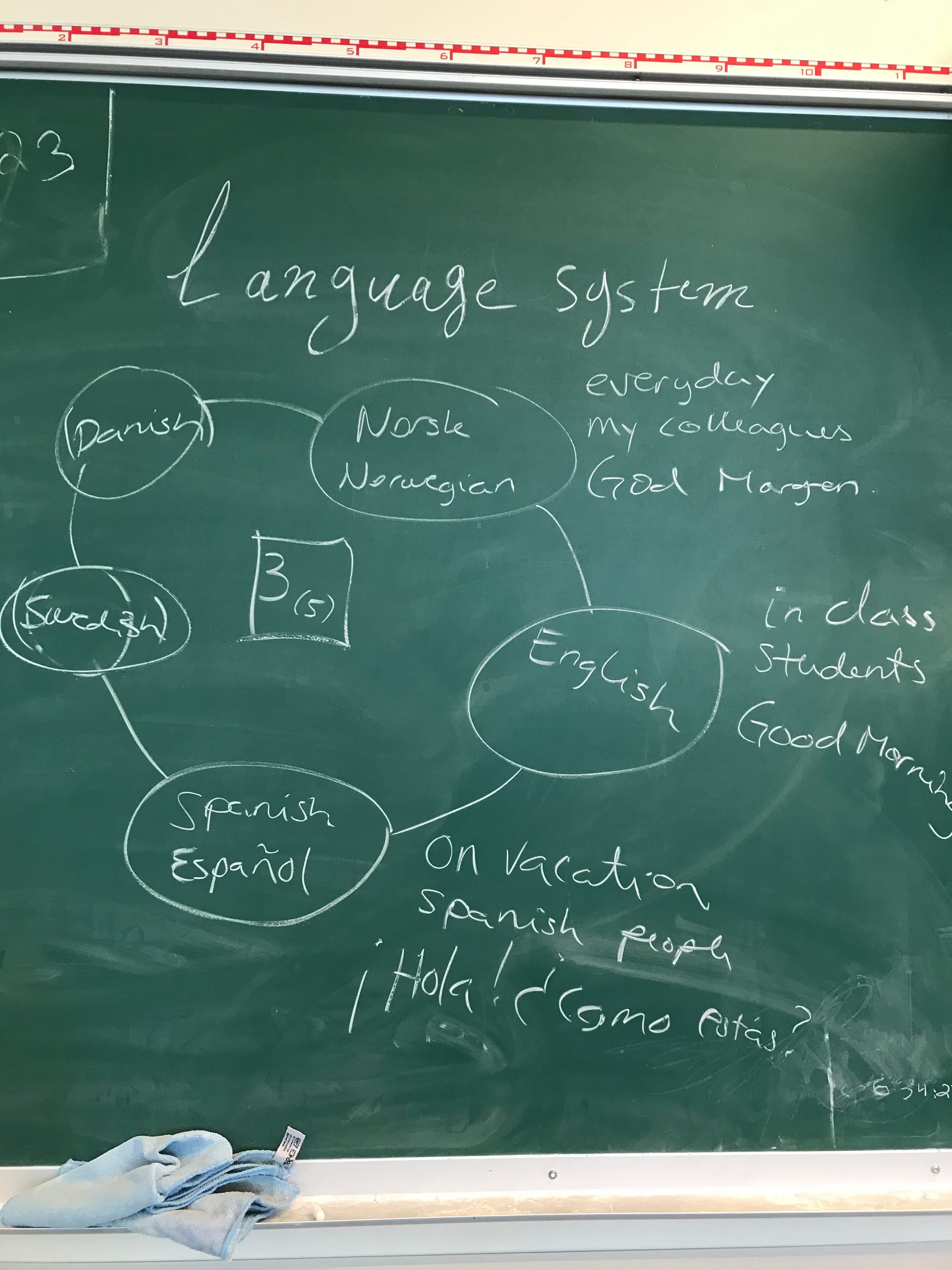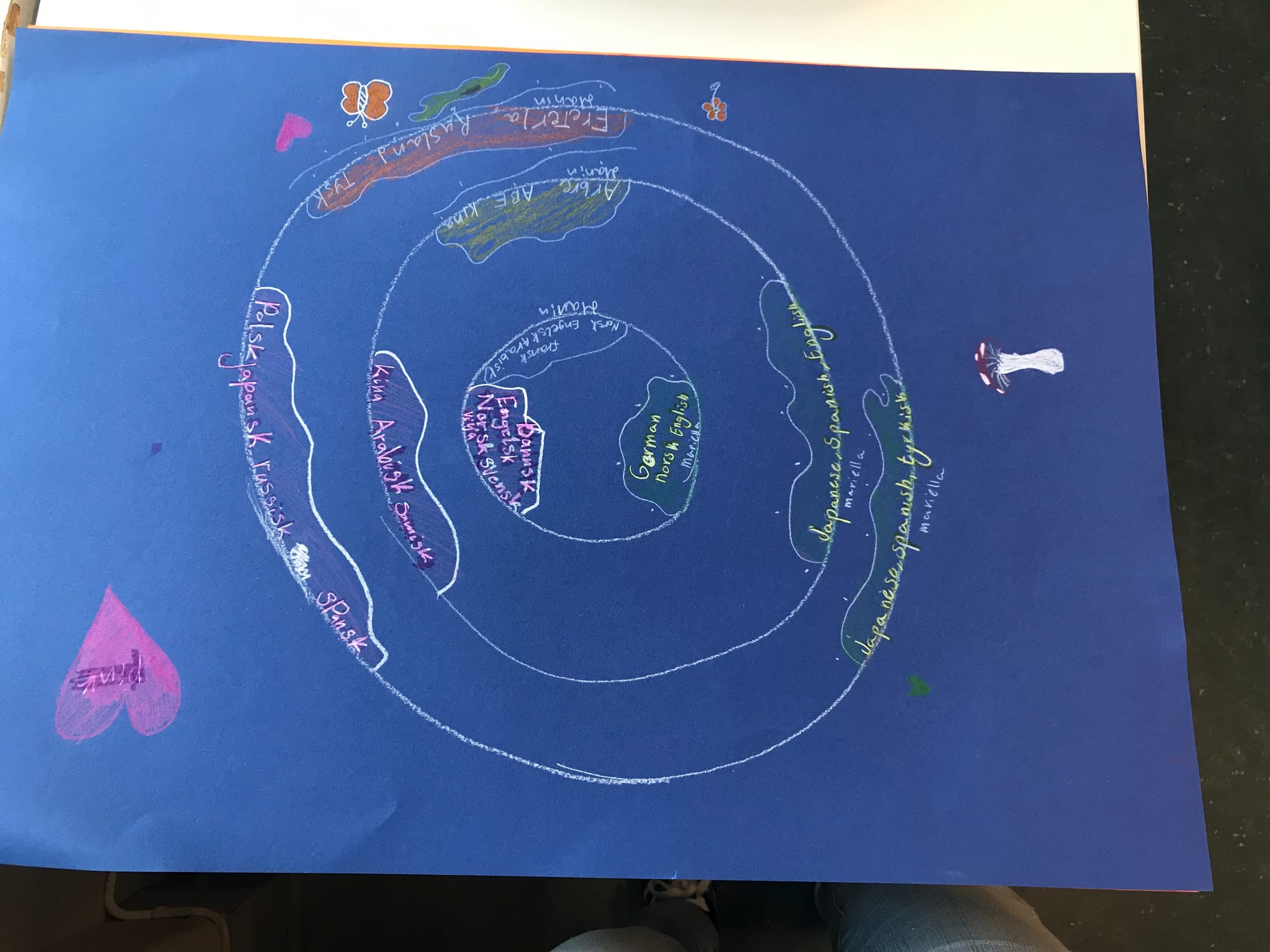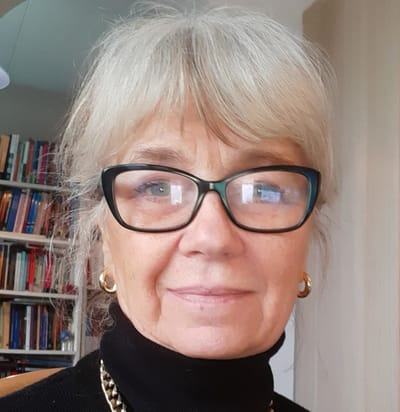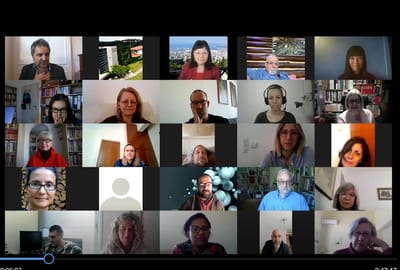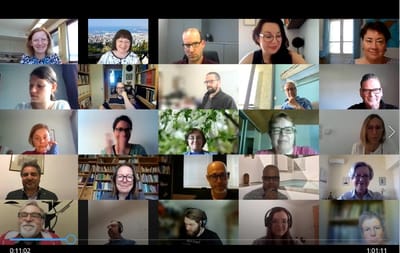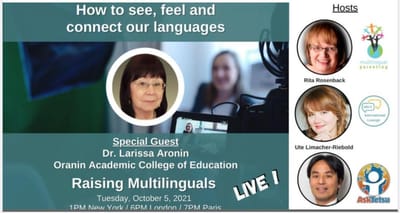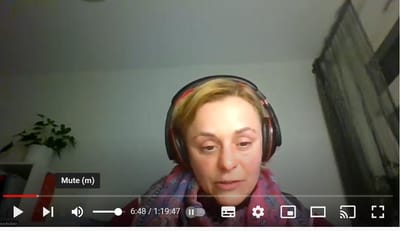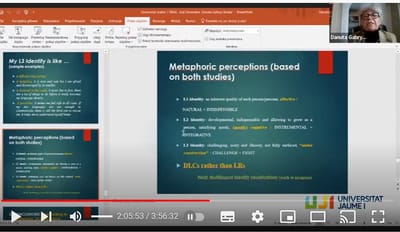Dominant Language Constellations (DLC)
MULTILINGUALISM and the global language practices
About this site
The pages of this site include:
- What is DLC?
- DLC Blog, there is a 'comments' facility. You are welcome to give your comments, participate in discussions, and add your own material on DLC for the colleagues and students to see and use. In addition, you can send us your opinion and materials via email - see the envelope icon in the upper right section of the screen.
- DLC Bibliography
- For Teachers
- For Parents
- For Researchers
- Computer-assisted DLC Modelling
So far there are pages dedicated to the work of
- Joseph Lo Bianco, Professor Emeritus at the Melbourne Graduate School of Education, Australia.
- Danuta Gabryś-Barker, University of Silesia, Poland
- Anna Krulatz and Yaqiong Xu Norwegian University of Science and Technology in Trondheim, Norway and their gallery
- Felix Banda, University of the Western Cape, Cape Town, South Africa
- Eva Vetter, University of Vienna, Austria
- Britta Hufeisen, Technische Universitat Darmstadt
- Siv Björklund and Mikaela Björklund, Åbo Akademi University, Finland
- and other researchers
Breaking News: A project on DLC submitted by Prof. Dr. Siemund and his research Team has been approved by the prestigious DFG fund. "Convergence on Dominant Language Constellations: World Englishes in their local multilingual ecologies".
what is DLC
DLC applies to both societal language contact and multilingualism and individual multilingual practices. DLC is a pedagogical tool in teacher education.
Vivian Cook (2016, p.10 ):
" DLC is one useful way of looking at multilingualism from a multi-competence perspective".
http://www.viviancook.uk/Writings/Papers/MC16Premises.html
Li Wei (2020, p. ix):
"With its emphasis on the dynamic and ever-changing nature of multilingualism and the need to embed our analysis and understanding in historical and ideological contexts, DLC makes an original and productive contribution to scholarship and knowledge".
Bernard Spolsky (May 2021, speech at the book launch):
"Particularly important was the application of the theory of DLC to education".
bibliography
edited volumes on DLC
DLC-1
Lo Bianco, Joseph and Aronin, Larissa (eds.) (2020) Dominant Language Constellations: A New Perspective on Multilingualism’. Cham, Springer.
C o n t r i b u t o r s: Joseph Lo Bianco - editor and supervisor; Suzanne Flynn, Felix Banda,Nikolay Slavkov, Susan Coetzee Van Rooy, Siv Björklund, Mikaela Björklund, Kaj Sjöholm, Éva Fernández-Berkes, Richard Nightingale, Sarasi Kannangara, Stela Krevelj, Sviatlana Karpava.
DLC-2
Larissa Aronin and Eva Vetter (eds.) (2021) Dominant Language Constellations Approach in Education and Language Acquisition. Springer.
C o n t r i b u t o r s: Joseph Lo Bianco - author of the foreword, supervisor; Eva Vetter -editor, Larissa Aronin -editor, Nikolay Slavkov, Silvia Melo-Pfeifer, Siv Björklund, Mikaela Björklund, Guðrún Gísladóttir, Anna Krulatz, Anne Dahl, Jennifer Duggan, Judith Yoel.
DLC-3
Larissa Aronin and Silvia Melo-Pfeifer (eds.) (2023) Language Awareness and Identity: Insights via Dominant Language Constellation approach Cham, Springer. Book series: Multilingual Education .
C o n t r i b u t o r s: Nikolay Slavkov -Foreword; Maya Böckh, Lisa Marie Brinkmann,Suzanne V. Dekker, Joana Duarte, Danuta Gabryś-Barker, Fethi Helal, Barbara Hofer,Maria Iakovou, Linde M. Kootstra, Nives Kovačić, Stela Letica Krevelj, Hanneke Loerts,Laurent Moccozet, Ana Sofia Pinho, Jorge Pinto, Sofia Stratilaki-Klein, Sofia Tsioli, Marina Vihou.
articles, book chapters and Ph.D theses (in alphabetical order)
Angit, Suria Selasih (2020) Languages and Learning amongst Orang Asli Students in Malaysia. Ph.D. thesis defended at Melbourne Graduate School of Education. http://hdl.handle.net/11343/274839
Aronin, Larissa (forthcoming). Dominant Language Constellations. In Carol A. Chapelle (ed.). The Encyclopedia of Applied Linguistics Second edition (pp. tba). Wiley-Blackwell.
Aronin, Larissa (2021). Dominant Language Constellations in Education: Patterns and Visualisations. In: Aronin L., Vetter E. (eds) Dominant Language Constellations Approach in Education and Language Acquisition. Educational Linguistics, vol 51.(pp.19-41). Springer, Cham. https://doi.org/10.1007/978-3-030-70769-9_2
Aronin, Larissa (2021). Dominant Language Constellations: Teaching and learning languages in a multilingual world. In Raza, K., Coombe, C., & Reynolds, D. Policy development in TESOL and multilingualism: Past, present and the way forward. (pp. 287-300). Cham, Switzerland: Springer.
Aronin, Larissa and Sílvia Melo-Pfeifer(2023). Introduction: Understanding Identity and Language(s) Awareness by dint of DLC. In L. Aronin & S. Melo-Pfeifer (Eds.), Language awareness and identity: Insights via dominant language constellations approach. (pp. 1-17).Springer.
Aronin, Larissa and Sílvia Melo-Pfeifer (2023). DLC, Identity, and Awareness: a posse ad esse. In L. Aronin & S. Melo-Pfeifer (Eds.), Language awareness and identity: Insights via dominant language constellations approach. (pp.285-291). Springer.
Aronin, Larissa and Moccozet Laurent (2021). Dominant Language Constellations: Towards Online Computer-Assisted Modelling. International Journal of Multilingualism.
https://doi.org/10.1080/14790718.2021.1941975
Aronin, Larissa (2019). ' What is Multilingualism?' in David Singleton and Larissa Aronin (eds.), Twelve Lectures on Multilingualism, Bristol: Multilingual Matters, pp. 3-34. https://www.multilingual-matters.com/page/detail/?k=9781788922074
Aronin, Larissa (2019). Dominant Language Constellation as a method of research. In E. Vetter, & U. Jessner (Eds.), International Research on Multilingualism: Breaking with the Monolingual Perspective (pp.13-26). Springer.
Aronin, Larissa (2019). Challenges of multilingual education: Streamlining affordances through Dominant Language Constellations. Stellenbosch Papers in Linguistics Plus, 58, 235-256.
Aronin, Larissa (2016). Multicompetence and Dominant Language Constellation. In V. Cook, & Li Wei (Eds.), The Cambridge Handbook of Linguistic Multicompetence (pp.142-163). Cambridge University Press.
Aronin, Larissa (2006). Dominant Language Constellations: An approach to multilingualism studies. In Muiris Ó Laoire (Ed.), Multilingualism in Educational Settings (pp. 140-159). Hohengehren: Schneider Publications.
Aronin, Larissa and Danuta Gabryś-Barker (2025) A New Perspective on Multilingualism and Multilingual Practices. In M.A. Christison and A. Krulatz (eds) Research on Multilingual Practices with Linguistically Diverse Learners in Diverse Contexts. (pp.3-27). Routledge/TIRF.
Aronin, Larissa and Muiris Ó Laoire (2004). ' Exploring multilingualism in cultural contexts: towards a notion of multilinguality", In C. Hoffmann & J. Ytsma (eds), Trilingualism in Family, School and Community, Clevedon: Multilingual Matters, 11-29.
Banda, Felix (2020). Shifting and Multi-layered Dominant Language Constellations in Dynamic Multilingual Contexts: African Perspectives. In: Lo Bianco J., Aronin L. (eds) Dominant Language Constellations: A New Perspective on Multilingualism. Educational Linguistics, vol 47. (pp. 75-93).Springer, Cham. https://doi.org/10.1007/978-3-030-52336-7_5
Björklund, Mikaela and Siv Björklund (2024). Multilingualism in Swedish-Medium Teacher Education in Finland. DLCs in the Light of Teacher Educators’ Institutional Constellation Charts and the Institutional Linguistic Landscape. In Danuta Gabryś-Barker and Eva Vetter (Eds.), Modern Approaches to Researching Multilingualism. Studies in Honour of Larissa Aronin (pp.249 --269). Springer.
Björklund, Siv & Björklund, Mikaela (2021). Embracing multilingualism in teacher education in Finland? DLC as a tool for analysing the state of multilingualism in policy and practice. In: Aronin L., Vetter E. (eds) Dominant Language Constellations Approach in Education and Language Acquisition. Educational Linguistics, vol 51. (pp.131-150). Springer, Cham. https://doi.org/10.1007/978-3-030-70769-9_7
Björklund, Siv, Björklund, Mikaela, & Sjöholm, Kaj. (2020). Societal versus individual patterns of DLCs in a Finnish educational context. Present state and challenges for the future. In: Lo Bianco J., Aronin L. (eds) Dominant Language Constellations: A New Perspective on Multilingualism. Educational Linguistics, vol 47. (pp. 97-115). Springer, Cham. https://doi.org/10.1007/978-3-030-52336-7_6
Boeckh, Nicolas & Laurent Moccozet (2021)3D visualisation of Dominant Language Constellations (DLCs) Institute of Information Service Science, CUI, University of Geneva
https://www.youtube.com/watch?v=ircgrC4ATkg
Brinkmann, Lisa Marie (2022) a review Larissa Aronin, Eva Vetter (Eds.), Dominant Language Constellations Approach in Education and Language Acquisition Springer, 2021 (eBook), 240 pp. ISBN 978-3-030-70768-2
Theory and Practice of Second Language Acquisition vol. 8 (2), 2022, pp. 1–6 https://doi.org/10.31261/TAPSLA.12378
Brinkmann, Lisa Marie (2023). “Speaking about my languages promotes my language awareness”: Student Teacher Beliefs about Language Awareness and Their Dominant Language Constellations. In L. Aronin & S. Melo-Pfeifer (Eds.), Language awareness and identity: Insights via dominant language constellations approach. (pp. 197-217). Springer.
Coetzee Van Rooy, Susan (2020). Dominant Language Constellations in the Language Repertoires of Multilingual South African Students. In: Lo Bianco J., Aronin L. (eds) Dominant Language Constellations: A New Perspective on Multilingualism . Educational Linguistics, vol 47. (pp. 139-165).Springer, Cham. https://doi.org/10.1007/978-3-030-52336-7_8
Coetzee Van Rooy, Susan (2018). Dominant Language Constellations in multilingual repertoires: Implications for language-in-education policy and practices in South Africa. Language Matters: Studies in the Languages of Africa, 49(3), 19-46.
Coetzee-Van Rooy, Susan and Ulrike Jessner (2024).Multilingual Awareness in South African Language Portraits: Exploring the Usefulness of a DMM and DLC Framework. In Danuta Gabryś-Barker and Eva Vetter (Eds.), Modern Approaches to Researching Multilingualism. Studies in Honour of Larissa Aronin (pp.345-377). Springer.
Christison, MaryAnn & Anna Krulatz (2025) Frameworks and Models for Promoting Multilingual Practices in Classroom Contexts. In M.A. Christison and A. Krulatz (eds) Research on Multilingual Practices with Linguistically Diverse Learners in Diverse Contexts. (pp.49-63). Routledge/TIRF.
Dekker,S.V., J. Duarte, H. Loerts & L.M. Kootstra (2023). “We Can Do More With It”: Dominant Language Constellations of Teachers in Multilingual Frisian Primary Schools. In L. Aronin & S. Melo-Pfeifer (Eds.), Language awareness and identity: Insights via dominant language constellations approach. (pp. 263-284). Springer.
Dendrinos, Bessie (2022) a review. Joseph Lo Bianco and Larissa Aronin (Eds.),
Dominant Language Constellations: A New Perspective on Multilingualism Springer 2020, 301 pp. Theory and Practice of Second Language Acquisition vol. 8 (2), 2022, pp. 1–18
https://doi.org/10.31261/TAPSLA.12445
Iakovou, Maria, Sofia Tsioli & Marina Vihou (2023). Dominant Language Constellation and plurilingual awareness: The case of Student Language Teachers in Greece. In Larissa Aronin and Sílvia Melo-Pfeifer (eds.) In L. Aronin & S. Melo-Pfeifer (Eds.), Language awareness and identity: Insights via dominant language constellations approach. (pp. 131-153). Springer.
Fernández-Berkes, Éva and Suzanne Flynn (2020).Where DLC Meets Multilingual Syntactic Development. In: Lo Bianco J., Aronin L. (eds) Dominant Language Constellations: A New Perspective on Multilingualism. Educational Linguistics, vol 47.(pp. 57-74). Springer, Cham. https://doi.org/10.1007/978-3-030-52336-7_4
Fürstenau, Sara & Katharina Brizić (2024): Confronting histories of inequality in
exploring multilingual pedagogies for Rromani speakers, International Journal of
Multilingualism, DOI: 10.1080/14790718.2024.2445197
Gabryś-Barker, Danuta (2023).Language repertoires or individual dominant language constellations: the reality of instructed educational settings in a (mostly) monolingual context. Larissa Aronin and Sílvia Melo-Pfeifer (eds.) In L. Aronin & S. Melo-Pfeifer (Eds.), Language awareness and identity: Insights via dominant language constellations approach. (pp. 107-129). Springer.
Gísladóttir, Guðrún (2021). Languages as Ways of Being: The Linguistic Biography of a Nordic Nomad. In: Aronin L., Vetter E. (eds) Dominant Language Constellations Approach in Education and Language Acquisition. Educational Linguistics, vol 51. (pp.225-240) Springer, Cham. https://doi.org/10.1007/978-3-030-70769-9_11
Gkaintartzi,Anastasia and Georgia Triantou (2023) Activating diversity: The use of dual
language books for critical plurilingual education. Journal of Applied Linguistics No
36 (2023).
Grasz; Kursiša (2024) Mehrsprachigkeit in Studienprogrammen für Fremdsprachen
– Möglichkeiten und Herausforderungen Nordic Journal of Language Teaching and
Learning, Vol. 12, No. 2, 2024. ISSN: 2703-8629. https://doi.org/10.46364/njltl.v12i2.1289
Grigorieva, Alexandra and Ekaterina Protassova (2025) Integrating International Foodways and the Dominant Language Constellation Approach in Language Studies. Education Sciences, 15(6), 765. https://doi.org/10.3390/educsci15060765
Haukås, Åsta, André Storto & Irina Tiurikova (2021) Developing and
validating a questionnaire on young learners’ multilingualism and multilingual identity, The Language Learning Journal, 49:4, 404-419, DOI: 10.1080/09571736.2021.1915367
To link to this article: https://doi.org/10.1080/09571736.2021.1915367 © 2021
Helal Fethi (2023) Dominant Language Constellations and Language Policy and Planning in Two Settings: Perspectives from Tunisia/Maghreb. In Larissa Aronin and Sílvia Melo-Pfeifer (eds.) In L. Aronin & S. Melo-Pfeifer (Eds.), Language awareness and identity: Insights via dominant language constellations approach. (pp. 21-43). Springer.
Helal Fethi (2023). Multilingualism in linguistic landscapes in Tunisia: a critical discourse analysis of language policy activities, International Multilingual Research Journal, DOI: 10.1080/19313152.2023.2209368
Henehan, Alison; Duarte, Joana (2024). Unveiling Pre-Service Teachers’ Cognitions of Multilingualism and Multilingual Identities Using a Multi-Method Approach. Treatises and Documents, Journal of Ethnic Studies, 93(93), 29-60. https://doi.org/10.2478/tdjes-2024-0011
Hill, Joseph C. & Eyasu Hailu Tamene (2022).Hierarchies and Constellations: Language Attitudes and Ideologies of Signed Languages. Journal of Sociolinguistics. https://doi.org/10.1111/josl.12525 (free to read)
Hofer, Barbara (2023). Applying DLC to the study and discussion of early multicompetence in a trilingual minority context in Northern Italy. In Larissa Aronin and Sílvia Melo-Pfeifer (eds.) In L. Aronin & S. Melo-Pfeifer (Eds.), Language awareness and identity: Insights via dominant language constellations approach. (pp. 69-85). Springer.
Hofer, Barbara (2023). A Multilingual Development Framework for Young Learners Early Multi-competence in South Tyrol. Mouton De Gruyter. Language Contact and Bilingualism.
ISBN:9783111104652
Hufeisen, Britta. (2018). Models of multilingual competence. In Andreas Bonnet & Peter Siemund (eds.), Foreign language education in multilingual classroom 7. Amsterdam: John Benjamins.
Huhtala, Anne, Kursiša, Anta, Vesalainen, Marjo (2021).“I’m in contact with foreign languages every day” : University language students and their multilingualism. European Journal of Applied Linguistics, Volume 9, Number 2, 9 September 2021, pp. 365-390(26).
https://www.degruyter.com/document/doi/10.1515/eujal-2019-0034/html
Kannangara, Sarasi (2020). The evolution of personal Dominant Language Constellations based on the amount of usage of the languages. In: Lo Bianco J., Aronin L. (eds) Dominant Language Constellations: A Perspective on Present-day Multilingualism. Educational Linguistics, vol 47.(pp. 169-186). Springer, Cham. https://doi.org/10.1007/978-3-030-52336-7_9
Karpava, Sviatlana, Mikaela Björklund and Siv Björklund (2023). In search of DLCS among multilingual young adults in Cyprus and Finland. The influence of multiple language use and practices on linguistic identity and trajectories as future teachers. In Siv Björklund and Mikaela Björklund (Eds.), Policy and Practice for Multilingual Educational Settings: Comparisons Across Contexts. BILINGUAL EDUCATION & BILINGUALISM: 138 (pp. 121-147). Multilingual Matters, Bristol, UK. ISBN-13: 978-1-80041-298-9 (hbk)/ ISBN-13: 978-1-80041-299-6 (pbk)
Karpava, Sviatlana (2020). Dominant Language Constellations of Russian Speakers in Cyprus. In: Lo Bianco J., Aronin L. (eds) Dominant Language Constellations: A Perspective on Present-day Multilingualism. Educational Linguistics, vol 47. (pp. 187-209). Springer, Cham. https://doi.org/10.1007/978-3-030-52336-7_10
Kee Mew Wan Khin, Evelyn (2023).Children’s voice in investigating their use of multilingual abilities in learning to read in two or more languages in the Mauritian context. Doctoral Thesis. University of Brighton https://research.brighton.ac.uk/en/studentTheses/childrens-voice-in-investigating-their-use-of-multilingual-abilit
Korsnes, Kamilla Helene (2024) Norwegian Elementary Pupils’ Dominant Language Constellation. Norske barneskole-elevers Dominante Språk Konstellasjoner Master thesis. Høgskulen på Vestlandet
https://hvlopen.brage.unit.no/hvlopen-xmlui/handle/11250/3137274
Krevelj, Stela Letica and Nives Kovačić (2023).DLC of consecutive multilinguals studying languages in an officially monolingual environment. In Larissa Aronin and Sílvia Melo-Pfeifer (eds.) In L. Aronin & S. Melo-Pfeifer (Eds.), Language awareness and identity: Insights via dominant language constellations approach. (pp. 173-194). Springer.
Krevelj, Stela. (2020). Studying crosslinguistic interaction in multilingual production through the Dominant Language Constellation. In: Lo Bianco J., Aronin L. (eds) Dominant Language Constellations: A Perspective on Present-day Multilingualism. Educational Linguistics, vol 47.(pp. 211-229). Springer, Cham. https://doi.org/10.1007/978-3-030-52336-7_11
Krulatz, Anna and Anne Dahl (2021). Educational and Career Opportunities for Refugee-Background Adults in Norway: A DLC Perspective. In: Aronin L., Vetter E. (eds.) Dominant Language Constellations Approach in Education and Language Acquisition. Educational Linguistics, vol 51. (pp.109-128). Springer, Cham. https://doi.org/10.1007/978-3-030-70769-9_6
Krulatz, Anna, & Duggan, Jennifer (2021). Exploring Identities and Life Stories of Multilingual Transnational Couples Through the Lens of Multilinguality and Dominant Language Constellations. In: Aronin L., Vetter E. (eds.) Dominant Language Constellations Approach in Education and Language Acquisition. Educational Linguistics, vol 51. (pp.173-201). Springer, Cham.
Krulatz, Anna, & Duggan, Jennifer (2018). Multilinguals and extensive reading: Two multilinguality portraits of learners of Norwegian. Reading in a Foreign Language, 30(1), 29-48.
Lakuš, Davor (2020).The Dominant Language Constellations of young multilinguals in an international school in Croatia. Master's thesis. University of Zagreb, University of Zagreb. https://urn.nsk.hr/urn:nbn:hr:131:681025
Lanvers, Ursula (2024) Language Learning beyond English
Learner Motivation in the Twenty-First Century. Series: Elements in Language
Teaching(CUP) DOI: https://doi.org/10.1017/9781009388795[Opens in a new window]
Legaz-Torregrosa, H., Machancoses, F. H., Buyse, K., & Fonseca-Mora, M. C. (2022). Musical aptitude and silent reading fluency in adult multilingual learners of Spanish: an exploratory study. International Journal of Multilingualism, 21(1), 78–91. https://doi.org/10.1080/14790718.2021.2025242
Lo Bianco, Joseph (2020). A Meeting of Concepts and Praxis: Multilingualism, Language Policy and the Dominant Language Constellation. In: Lo Bianco J., Aronin L. (eds) Dominant Language Constellations. Educational Linguistics, vol 47. (pp.35-56). Springer, Cham. https://doi.org/10.1007/978-3-030-52336-7_3
Lo Bianco, Joseph (2020). Quo Vadis, DLC? In J. Lo Bianco and Aronin L. (eds.) Dominant Language Constellations: A New Perspective on Multilingualism. Educational Linguistics, vol 47. (pp. 261-275).Springer, Cham. https://doi.org/10.1007/978-3-030-52336-7_13
Lo Bianco Joseph (2021). Literacy Learning and Language Education: Dominant Language Constellations and Contemporary Multilingualism. In: Aronin L., Vetter E. (eds) Dominant Language Constellations Approach in Education and Language Acquisition. Educational Linguistics, vol 51. (pp.1-16). Springer, Cham. https://doi.org/10.1007/978-3-030-70769-9_1
Lo Bianco, Joseph and Larissa Aronin (2020). Introduction: The Dominant Language Constellations: A New Perspective on Multilingualism. In: Lo Bianco J., Aronin L. (eds) Dominant Language Constellations: A New Perspective on Multilingualism. Educational Linguistics, vol 47. (pp.1-15). Springer, Cham. https://doi.org/10.1007/978-3-030-52336-7_1
Lopopolo, Olga, Bienati, Arianna, Jennifer-Carmen Frey, Aivars Glaznieks, Stefania Spina (2024). Categorising speakers' language background: Theoretical assumptions and methodological challenges for learner corpus research. Research Methods in Applied Linguistics.
Melo-Pfeifer, Silvia (2023).The dynamics of Dominant Language Constellations: Moments of linguistic ecological transition as portrayed by pre-service foreign language teachers. In Larissa Aronin and Sílvia Melo-Pfeifer (eds.)In L. Aronin & S. Melo-Pfeifer (Eds.), Language awareness and identity: Insights via dominant language constellations approach. (pp. 247-261). Springer.
Moccozet, Laurent & Maya Böckh (2023). Digital DLC models as instruments for raising awareness and better understanding of current multilingualism in HEI. In Larissa Aronin and Sílvia Melo-Pfeifer (eds.)In L. Aronin & S. Melo-Pfeifer (Eds.), Language awareness and identity: Insights via dominant language constellations approach. (pp.45- 65). Springer.
Mocozet Laurent, & Nicolas Boeckh, Larissa Aronin (2021) Modelling socio-linguistic profiles in multilingual Higher Education Institutions (HEI) ITHET 2021 ITHET - The Future of Education Powered by IT and AI, 19th International Conference on Information Technology Based Higher Education and Training. presented November 5, 2021. ITHET 2021 - ConfTool Pro - BrowseSessions
Nightingale, Richard (2020). A Dominant Language Constellations perspective on language use and the affective domain: A case study of a Moroccan immigrant living in the Valencian Community. In J. Lo Bianco & L. Aronin (Eds.), Dominant Language Constellations: A Perspective on Present-day Multilingualism. Springer. Educational Linguistics, vol 47. (pp. 231-259).Springer, Cham. https://doi.org/10.1007/978-3-030-52336-7_12
Nightingale, Richard (2024).“There Are More Diversities in Multilingualism”: Visualising Dominant Language Constellations to Raise Awareness of Multilingualism in Future Language Teachers In Danuta Gabryś-Barker and Eva Vetter (Eds.), Modern Approaches to Researching Multilingualism. Studies in Honour of Larissa Aronin (pp. 295 -322). Springer.
Pinho, Ana Sofia(2023). Pre-service Teachers’ Professional Identity and Representations of English as a Foreign Language: toward a Dominant Language (Teaching) Constellation? In L. Aronin & S. Melo-Pfeifer (Eds.), Language awareness and identity: Insights via dominant language constellations approach. (pp. 219-245). Springer.
Pinto, Jorge (2023).Are teachers developing strategies to enhance the use of DLC in the learning of Portuguese as a foreign language in English-dominant Classrooms? In L. Aronin & S. Melo-Pfeifer (Eds.), Language awareness and identity: Insights via dominant language constellations approach. (pp. 155-172). Springer.
Rauhala, Mika (2018). Språkanvändning Och Språkbehärskning Hos Polyglotter - En Fallstudie Om Sex EU-Informanters Flerspråkiga Språkbruk Inom EU [Master Thesis]. Vasa Universitet.
Seidl, Eva (2022). The Multilingual Classroom in Translator Education: Students and Teachers as Co-Participants. In Sviatlana Karpava (Ed.), Handbook of Research on Multilingual and Multicultural Perspectives on Higher Education and Implications for Teaching (pp.339-352). Hershey: IGI Global. https://doi.org/10.4018/978-1-7998-8888-8.ch015
Slavkov, Nikolay (2020).Language Background Profiling at Canadian Elementary Schools and Dominant Language Constellations. In: Lo Bianco J., Aronin L. (eds) Dominant Language Constellations. Educational Linguistics, vol 47. (pp. 117- 138).Springer, Cham. https://doi.org/10.1007/978-3-030-52336-7_7
Slavkov, Nikolay (2021). Family Language Policy and Dominant Language Constellations: A Canadian Perspective. In: Aronin L., Vetter E. (eds) Dominant Language Constellations Approach in Education and Language Acquisition. Educational Linguistics, vol 51. (pp.87-108). Springer, Cham. https://doi.org/10.1007/978-3-030-70769-9_5
Slavkov, Nikolay (2023). Foreword: Some reflections on Dominant Language Constellations at the Doctor's Office.In L. Aronin & S. Melo-Pfeifer (Eds.), Language awareness and identity: Insights via dominant language constellations approach. (pp. v-xi). Springer.
Sugrañes Caterina (2017). A Plurilingual Approach to Teaching and Learning Languages in Catalonia: Using Heritage Languages in the Additional Language Classroom [Doctoral thesis]. Universitat Ramon Llull.
Sugrañes, Caterina (2021). Promoting Plurilingual Competences in Primary Schools in Barcelona: A Dominant Language Constellation Approach to Teaching and Learning Languages. In: Aronin L., Vetter E. (eds) Dominant Language Constellations Approach in Education and Language Acquisition. Educational Linguistics, vol 51. (pp.61- 86). Springer, Cham.
Vetter, Eva (2018). Language Education Policy through a DLC Lens: The Case of Urban Multilingualism. Paper presented at the 11th International Conference on Multilingualism and Third Language Acquisition. Themed Symposium: Dominant Language Constellations in Education and Social Contexts. Lisbon, 14th of September.
Safatian, Fakhereh, Christison MaryAnn, Yaqiong Xu, & Anna Krulatz (2025) Understanding Multilingualism in Higher Education Institutions through the Framework of Dominant Language Constellation. In M.A. Christison and A. Krulatz (eds) Research on Multilingual Practices with Linguistically Diverse Learners in Diverse Contexts. (pp.250-265). Routledge/TIRF.
Simungala, Gabriel (2025) Linguistic Landscapes and Dominant Language Constellations:
The Multilingual Behaviour of Minoritised Migrant Populations in Lusaka, Zambia,
Language Matters, 56:1, 3-23, DOI: 10.1080/10228195.2025.2460031 To link to this article:
https://doi.org/10.1080/10228195.2025.2460031
Stratilaki-Klein, Sofia (2023).Dominant Language Constellations in Luxembourg: Clusters of Identities and Networks of Representations of Plurilingualism. In L. Aronin & S. Melo-Pfeifer (Eds.), Language awareness and identity: Insights via dominant language constellations approach. (pp. 87-106). Springer.
Triantou, Georgia (2023).Multilingual storytelling: From theory to practice: A
case study in a preschool class in Lakonia. Postgraduate Dissertation. Supervisor: Gkaintartzi Anastasia, Hellenic Open University.
Vetter, Eva (2021). Language education policy through a DLC lens: the case of urban multilingualism. In: Aronin L., Vetter E. (eds) Dominant Language Constellations Approach in Education and Language Acquisition. Educational Linguistics, vol 51. (pp.43-59). Springer, Cham. https://doi.org/10.1007/978-3-030-70769-9_3
Vetter, Eva (2024). Dominant Instead of Hidden? A Critical Discussion on a European DLC Including Endangered Languages In Danuta Gabryś-Barker and Eva Vetter (Eds.), Modern Approaches to Researching Multilingualism. Studies in Honour of Larissa Aronin (pp.227 -247). Springer.
Wang, T. (2024). Reflection and reflexivity in influencing the developmental trajectories of ideal multilingual selves: a longitudinal qualitative inquiry. Journal of Multilingual and Multicultural Development, 1–16. https://doi.org/10.1080/01434632.2024.2418474
Yu, W., & Xu, H. (2024). Non-participation and the stability of Dominant Language Constellation in contextual shifts: the case of a Hong Kong multilingual student. Journal of Multilingual and Multicultural Development, 1–14. https://doi.org/10.1080/01434632.2024.2380390
Xu, Hao and Shan, Zhibin (2021)Teaching and Learning Multiple Varieties of a Foreign Language for Sustainable Multilingual Education. Sustainability 2021, 13, 8004. https://doi.org/10.3390/su13148004
Yaqiong (Sue) Xu and Anna Krulatz (2023) Reflective Practice in CPD for EAL Teachers in Norway: A DLC Approach. In Cirocki, A., Farrelly, R., & Buchanan, H. (Eds.), Continuing professional development for TESOL practitioners: A global landscape. Springer.
Xu, Yaqiong (2023). From a monolingual mind to a multilingual heart: An autoethnography through dominant language constellation. The Qualitative Report, 28(2), 448-464. https://doi.org/10.46743/2160-3715/2023.5880
Xu,Yaqiong and Anna Krulatz (2024).Employing Dominant Language Constellation in Teacher Professional Development: The Impact on EAL Teachers’ Beliefs, Practices, and Multilingual Identity In Danuta Gabryś-Barker and Eva Vetter (Eds.), Modern Approaches to Researching Multilingualism. Studies in Honour of Larissa Aronin (pp.271-293). Springer.
Yoel, Judith (2021). The Reconfiguration of the DLCs of Immigrant Teacher Trainees in Israeli Colleges. In L. Aronin & E. Vetter (eds.). Dominant Language Constellations Approach in Education and Language Acquisition. Educational Linguistics, vol 51. (pp.151-169). Springer, Cham.
For teachers
This is the time when teaching languages is bound to take into consideration the global transformations. The language practices of today are expressly multilingual and selected sets of languages, called Dominant Language Constellations are linguistic 'units of circulation'. Today, teaching English to speakers of other languages, teaching minority languages and teaching through minority languages, developing awareness in languages and planning language policies, involves recognizing the role of languages, both international ones and regional and minority ones, essential for particular localities. In order to implement a de facto multilingual paradigm, instead of only paying lip-service, it is necessary to reconsider language policies and modify curricula, teaching methods and activities in accordance with a multilingual perspective. Adopting the DLC perspective also means developing appropriate teaching activities, techniques and materials in order to naturally and efficiently integrate other students' languages into the acquisition of English as a second, foreign or additional language. As opposed to longstanding perception of the interaction between English and LOTE in a multilingual world as 'English against other languages', it is becoming increasingly clear now that the more realistic and fruitful way of dealing with multilingualism is 'English and other languages'.
In addition to more traditional verbal teaching methods, procedures and activities such as reading, writing and translation tasks, various visualization techniques including DLC maps, DLC images, tangible manual craft DLC representations and models are being intensively developed. These are beneficial for several reasons. Firstly, they serve as legitimate research tools for scholars of education and language teaching as well as language policy decision makers to monitor and analyse complex situations. Furthermore, they are of prime importance for all the TESOL and language teaching stakeholders in that pondering visual images and models enhances language awareness and language responsibility in learners and users of multiple languages. The educational effect of these DLC-related activities spills over purely linguistic concerns to the realm of social coherence, economics, intercultural communication and the personal self-efficacy and well-being. For this reason, more research and professional development of methods and materials are to be carried out in the future that involve not only English but also the DLC languages in their various manifestations: symbolic, verbal, material and digital. How exactly considering important languages in teaching multilingual learners is to be carried out in each particular setting is a matter of current and also near-future research and ongoing educational creative practices and initiatives. The DLC approach for language teaching is gaining momentum, but it is only at the beginning of its exciting path of innovations.
DLC in English-Teaching Practices
With language policies and language teaching approaches of TESOL moving toward a multilingual paradigm, the task of reconsidering the strategies in teaching English to speakers of other languages becomes more realistic. A teacher can employ various DLC-oriented practices in the classroom.
Curricula, Lesson Plans, and Teaching Materials
Considering DLC (in broader understanding, multilingualism) in English teaching means that curricula, lessons, and teaching methods reflect the languages of students’ dominant constellations. This does not imply sporadic and superficial reference to all the languages every minute and day; rather the consideration should be systematic, naturally inbuilt in the tissue of daily life and teaching. For instance, one such learning activity is modifying the lesson template, so that it would incorporate the entire DLC rather than only the native language and English Such a formal reminder of languages additional to the target English together in one framework helps to address practical issues, and in that it delineates and brings out the entire set of important languages. Having all the DLC languages systematically in the teachers’ attention zone aligns their professional thinking along the current sociolinguistic reality, where the languages are intermixed in social spaces and multilingual skills work in concert. Such a systemic modification of teaching arrangements makes teachers and planners always remember and focus on interactions and interrelations of languages implicated in teaching English.
Teaching and Learning Activities: Creative Tasks, Visualizations, and Modeling
One more way of addressing multilingualism while teaching English to speakers of other languages is organizing activities directed at enhancing their awareness of languages globally and in their personal life. Their understanding should not be limited to just “knowing about” other languages and eating each other’s ethnic food. The language learners are entitled to a deeper and more active realization of the profound and crucial involvement of languages in contemporary life. Teachers are those who can enable learners to competently manage their language assets through DLC. An inspiring example is how Sugrañes (2021) applied the DLC approach in the English language classroom in a primary school in Barcelona, where Spanish, Catalan, and English are the curricula languages. The plurilingual pedagogical strategy of the school is based on promoting translanguaging and using other languages of the pupils for metalinguistic reflection and learning. In order to bring forth the pupil’s DLCs, various activities are used, including story reading, illustrating their stories, and “reading in English, speaking in our own languages.” The pupils created story books in English which were then translated into the pupils’ own languages and read by them to the younger children in English and in all the languages of the class. Using translation and variously engaging multilingual pupils’ own languages for learning, English did not inhibit their learning outcomes in any of the DLC languages, but proved to be beneficial for learning, motivation, and attitudes toward languages. In addition, Sugrañes’ study demonstrated a positive impact of the DLC approach on the teachers’ performance and their willingness and competencies to “act plurilingually.” One can also think of classroom activities beyond the English lesson such as discussions and disputes, writings and crafts that would induce students to interact, think, and compare.
Visualizations have become widespread tools in education in pedagogy. Researchers resort to visual methods of social representations of multilingualism and DLCs as thoughts and feelings are not always easily expressed verbally. Melo-Pfeifer (2021) analysis visual linguistic autobiographies of foreign language student-teachers at Hamburg University and highlights the intricate, dynamic, and unpredictable evolution of an individual DLC. On the basis of her study, she suggested distinguishing between the latent and actual DLC which has implications for the educational language policy in Germany and internationally. Visualizations in teaching English to speakers of other languages are instrumental in rendering supposedly multilingual but in reality monolingual teaching into a de facto multilingual approach. DLC maps (Fig. 1a–c) are not the only visualization options any more. Modeling and manual craft representations of DLC are additional expressive means of bringing home the idea of multilingual reality to both learners and teachers of English. While for the learners, DLC models serve both as a cognitive extension and a material symbol of one’s own sociolinguistic existence and the language skills that ensure this existence, for language teaching specialists models provide insight both into the profession and into their own identity (see e.g., Gísladóttir, 2021). The simplest handmade models of personal DLCs can be easily produced by the language learners themselves, from playdough of different colors and sticks. Spheres of different colors represent languages; the bigger a sphere’s size, the higher the proficiency. The linguistic distance is defined by multilinguals since educators seek to unfold the subjective feelings of a language user and learner regarding their own language unit in the activity of DLC modeling. The greater the linguistic distance between languages, the longer the strips connecting the spheres. Handmade models prove especially beneficial for awareness and emotional involvement. Creating models and tangible representations of DLC involves not only mental energy but also physical activity by hands; and the impact of such complex activity is more pronounced.
NEW for teachers
REFERENCE
Xu, Y., & Krulatz, A. (submitted). Employing Dominant Language Constellation in CPD: The Impact on EAL Teachers’ Beliefs, Practices and Multilingual Identity. In Cirocki, A., Farrelly, R., & Buchanan, H. (Eds.), Continuing professional development for TESOL practitioners: A global landscape. Springer.
ABSTRACT
While the numbers of multilingual students in classrooms around the world are on the increase, research suggests that teachers of English as an additional language (EAL) feel insufficiently prepared to work with linguistically diverse learners. Consequently, there have been calls for more focus on diversity and multilingualism in teachers’ continuing professional development (CPD). This chapter presents a CPD project that utilized the construct of dominant language constellation (DLC) and employed DLC as an approach in order to investigate the impact of the CPD on three EAL teachers’ beliefs, multilingual teaching practices (MTPs), and multilingual identity. The data consisted of the following CPD activities: 1) Discussion of teacher’s own linguistic repertoire (pre-interview), 2) Teacher reflection on their own DLC (1st CPD workshop), 3) Group discussion about implementation of a DLC-focused lesson (2nd workshop), 4) DLC lesson planning and delivery, and 5) Individual reflection on the DLC lessons (post-interview). By illustrating how the language awareness, the teaching competence, and the multilingual identity of the three teachers became enhanced, the authors argue that DLC is a tangible CPD model that can alter teachers’ beliefs towards the students’ use of home languages (HLs), enrich MTPs, and enact teachers’ and students’ multilingual identity to forge the multilingual turn in EAL education.
EXTRACTS
1. An Overview of DLC-focused CPD Practices
| CPD Practice | Focus | Period |
| Individual teacher interview (Pre-interview) | Teachers’ reflections on working in the EAL context | October-November, 2020 |
| 1st DLC-focused workshop | Teachers reflect on their own DLCs | December, 2020 |
| 2nd DLC-focused workshop | Teachers discuss implementation of the DLC-focused lesson | January,2021 |
| Researcher-teacher collaborating on DLC lesson planning and delivery | The researcher and the teacher co-plan and co-conduct the DLC lessons | March-May, 2021 |
| Individual teacher interview (Post-interview) | Teachers reflect on the conducted DLC lessons | After the DLC lesson |
Figure 1: Teachers’ drawings of their DLCs as a manifestation of their multilingual identity
3. During the DLC lessons:
Figure 1. Teacher shares her DLC and explains DLC to the students (see Gallery)
Figure 2: Students’ DLC products as demonstrations of the affirmed multilingual identity (see images on this page)
for parents

https://www.youtube.com/watch?v=2Mie5Mw2pGw
DLC as a tool for multilingual socialization and for developing multilingual awareness that allows parents and educators to get more information about language use and acquisition.
We know that multilinguals are not multiple monolinguals in one.
Multilinguals have the advantage to always have the repertoire of their languages at their disposal.
What kind of language repertoire do our children acquire or learn?
What part of this repertoire do we use in our day-to-day life?
How do our different languages work together in a particular context?
Do our languages dominate one another or do they follow a pattern?
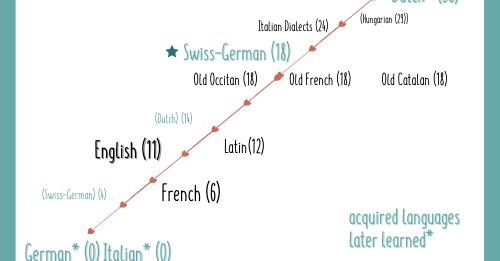
UTESINTERNATIONALLOUNGE.COM How to portray, feel and explain language use for a multilingual - Ute's International Lounge
for researchers
It is not a secret that, while the ideas of multilingualism gain currency, there is still a lot of instances when a monolingual perspective is in action. The "monolingual perspective" still reigns in research where multilingualism is often conceived of multiple monolingualism. By using Dominant Language Constellations as a starting point for the study of language practices, we de facto move from monolingual to a multilingual perspective.
What to research
A constellation of languages rather than a single language is the point of departure for mapping languages of the world. The traditional view actually succumbs to the monolingual perspective in that it sees each language separately in linguistic maps. Sociolinguists are then, visually compelled to describe the world in a ‘flat’ way. In the light of the majority of the world's population and the world's states is multilingual, it would be more accurate to present the linguistic makeup of the world according to DLCs, rather than according to single languages. The prerequisite for updating and restructuring the view, according to already theoretically accepted visions and theories, is gathering a pool of data on how sets of languages are distributed across territories and communities of the world, and create DLC lists and maps.
The first necessity is to gather more descriptive studies on Dominant Language Constellations. We would like to know which Dominant Language Constellations operate in the world. Which DLCs are there in a particular country? Which are the most numerous, and which are the rare Language Constellations? Which languages constitute these Dominant Language Constellations? Which Dominant Language Constellations are essential for the life of certain communities or individuals and which are less so? One of the first studies to outline and analyze Dominant Language Constellations in a country is the paper by Sjöholm, Björklund and Björklund (2016) describing DLCs in multilingual Finland. The authors looked into the diverse Dominant Language Constellations among student teachers with different language backgrounds and in differing language environments. In addition, the study yielded data on why and how some languages enter a DLC and leave it to return to their place as a part of a repertoire.
A description of the language makeup of counties, organizations, and communities can be done from politico-geographical, educational, economic or any other angles of view depending on the discipline of the researchers, research interests and reality demands. Among the questions posed can be: Which Dominant Language Constellations predominate numerically in particular countries? Which DLCs (if any) seem to correspond with the better financial and political societal status and success in a country and which seem to hinder social adaptation?
The next step would be to investigate characteristics of particular Dominant Language Constellations and identify the characteristic features common to all DLCs. In the field of Language Policy, it would be illuminating to look into the subject towards particular Dominant Language Constellations, especially those including minority languages. Which DLCs are supported by the state, which are not? What are the reasons for its support or neglect? What are the ways of managing Dominant Language Constellations in a community, country or organization?
In order to study individual Dominant Language Constellations and typical DLC configurations in more depth, one may also examine the configuration of languages and skills in a DLC, the distribution of practical functions in the DLC, and define how much time, effort and expenses are devoted to each language of the DLC and how these expenditures are coordinated in one DLC entity. Minority studies, ethics, ethnology of multilingualism, multiple language acquisition (SLA and TLA inclusive) are conveniently approached from the DLC perspective because, on the one hand, a DLC structure limits the number of agents to be researched, and on the other hand, adopts complexity methods and views which are especially appropriate for these lines of research. The work by Stela Letica Krevelj (2017), for example, focuses on the interaction of languages within a DLC of Croatian/Italian/English in Croatia with regard to emerging patterns and variation in linguistic behavior. A wide variety of studies can be performed and insights gleaned from comparative research. The search for correlations and comparison can be carried out in various directions. For example, it would be informative to check whether there is a correlation between individual and communal Dominant Language Constellations in a country. It is possible then to consider whether it is beneficial for a country or for a minority community when an officially encouraged DLC or DLCs correspond with individual ones.
Other studies can compare different kinds of DLCs. Dominant Language Constellations containing various particular languages, or languages with different writing systems. Do users whose Dominant Language Constellations contain two or three differing writing systems such as hieroglyphics, or Semitic languages (Hebrew/ Arabic) with their right to left writing and Latin (German, French, Spanish) and Cyrillic (Russian, Ukrainian) have significantly greater metalinguistic awareness? A relatively new kind of a DLC which appeared and spread all over the world is that with a combination of languages originating from geographically distant localities. The number of such DLCs (e.g. Chinese/ German/ English; Singhalese/ English/ German; or Korean/ English/ Spanish) has increased due to current mobility routes. Other research questions probe the Dominant Language Constellations, which may ensure or enhance the preferred teaching, learning and social outcomes. Which DLC configuration provides more cognitive and social advantages for the individual? Berkes & Flynn (2012: 21) have shown that “certain language constellations may be beneficial for the learner as they 10 facilitate the acquisition of syntactic features carried by functional elements”, and they discuss the important repercussions of their research for language teachers. Moreover, there is the question about whether DLC languages have a different or similar influence on the desired outcomes as compared to the languages of one’s repertoire. In her study on multilinguals with Polish, L2 English, and various L3-Ln from the Germanic, Romance, Slavonic and non-Indo-European groups, Agnieszka Otwinowska-Kasztelanic (2016) tried to determine whether all languages within the learner’s linguistic repertoire or only those in his/ her Dominant Language Constellation (DLC) have an impact on guessing unknown, formally similar words. Her results reveal that the sum of all languages in the repertoire does not predict that the multilingual will employ inference strategies.
How to research DLC
A Dominant Language Constellation reflects the real-life use of concrete named languages. At the same time, it is a mental construct, enabling us to think about multilingualism from a different angle. The Dominant Language Constellation approach emphasizes the two features of DLC that enrich the methodology of research in multilingualism. The first is “considering whole sets of languages as units, rather than focusing, one by one, on the specific languages used by given individuals or groups.” (Aronin & Singleton 2012: 69). The second feature which is important for research is seeing DLC as a pattern.
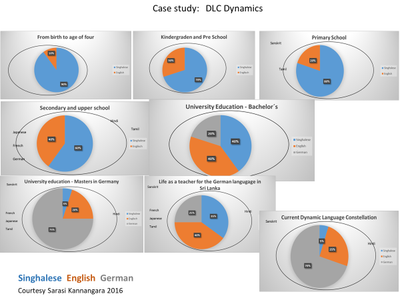
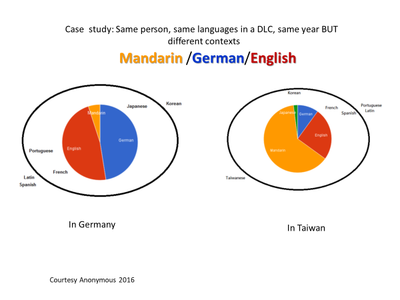
Computer-assisted dlc modelling
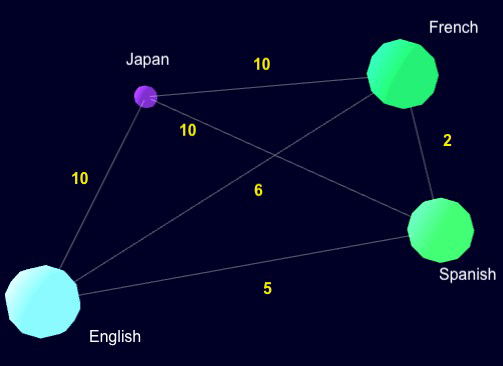
Computer- assisted DLC Modelling
Individual DLC models self-created by users with the mediation of software programs can be used as awareness raising means for multilingual speakers. They help each one to appropriate their own language assets through geometric and visual properties rather than habitually neglecting them. Producing one's personal combination of language skills is an informative and emotionally rewarding activity for language users of various ages. DLC modelling is important for language users, learners and researchers because it helps them understand that they interact with a language-culture-setting entity that functions as a unit. It possesses unique qualities that are not reducible neither to characteristics of particular languages, or to their pair-interactions, nor only to a particular speaker's abilities. DLC modelling aims to uncover this additional value and unique quality that each DLC possesses. DLC databases enable learners, teachers, researchers, education and social practitioners, and governmental bodies to quickly find important information about particular features of multilingual social groupings and individuals and allow for their detailed study and comparison. In addition to individual language users, there exist multiple other stakeholders who need to see both the whole picture and the details of particular sociolinguistic situations. These include city and regional authorities, language policy developers, administrators at schools and universities, teachers, social workers and researchers. For all of these, DLC modelling can be instrumental. See the demo by Laurent Moccozet and Nicolas Boeckh , Institute of Information Service Science, CUI University of Geneva https://youtu.be/ircgrC4ATkg 3D visualisation of Dominant Language Constellations (DLCs) - YouTube
Learn MoreThe 12th International Conference on Third Language Acquisition and Multilingualism 15-17 September
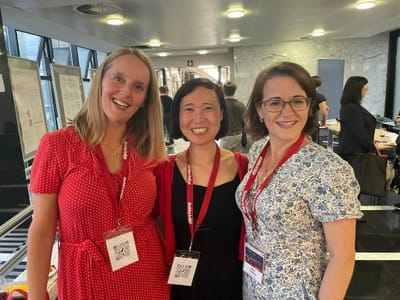
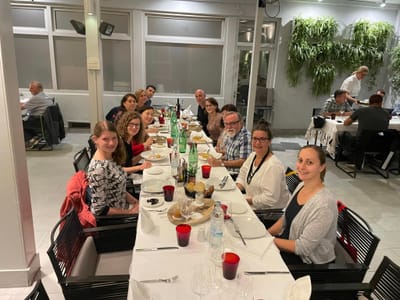
- DLC approach at
15-17 September 2022, Zagreb, Croatia
15.09.2022 Symposium: Engaging with Dominant Language Constellations (DLCs) in the North convenor: Nayr Ibrahim
1. Duggan & Krulatz: Evolving DLCs and identity transformation in multilingual transnational couples
2. Haukås, Storto & Tiurikova: Mapping multilingual practices and beliefs in Norwegian lower secondary schools
3. Ibrahim: Teachers discovering and embracing their DLCs – a concrete and visual pathway to multilingual classrooms
4. Xu: Detecting DLCs in EFL teachers’ lives: navigating teaching practices in multilingual classrooms
15.09.2022 presentatons:
Letica Krevelj & Kovačić: If you mind, it does matter? Defining DLCs in consecutive multilinguals’ repertoires
Björklund & Björklund: DLC as a tool to document, describe and develop the multilingual state, tensions and potential in teacher practices in Finland
Dekker, Kootstra, Loerts, & Duarte: Towards a Typology of Attitudes, Knowledge and Skills within Educational Dominant Language Constellations
Joseph Lo Bianco
From 2011-2017, Joseph served as Research Director of the UNICEF Language and Peacebuilding initiative in Malaysia, Myanmar and Thailand, and as Senior Research Advisor for the European Commission project Languages in urban communities: Integration and Diversity for Europe (LUCIDE).
In his work he supports international research projects in several countries on language planning, multiculturalism and intercultural education and also advises on language, culture and literacy education, the integration of indigenous and immigrant children into mainstream schools, and reconciliation and peace through education.
Joseph combines research studies with practical intervention to help people affected by conflict to promote social cohesion and peace-building. He has published extensively, with over 32 books and 130 articles and chapters. His research interests also include Asian studies and Italian language and cultural history.
Prof. Lo Bianco brought to attention the wide array of what is encompassed by DLC, and develops material illuminating DLC in language policy and planning, script/orthography, and related areas. Prof. Lo Bianco supervises the research on DLC in Malaysia, Tunisia and Australia , but also in North America.
Excerpts from Joseph Lo Bianco's works on DLC:
"The Dominant Language Constellation is an important notion that should be applied to such settings to build a more accurate picture of communicative life in contemporary societies. It can replace obsolete ideas that nations and individuals are monolingual or that ordinary communication is typified by use of rigidly discrete and separately bounded languages. The DLC can build a shared stock of concepts about language in society between public officials and scholars whereas other analytical approaches to multilingualism have less traction of this sort" (Lo Bianco 2020, p. 266).
"It [DLC]now robustly includes individuals but also groups, institutions within societies as well as whole societies, and sub-national parts or regions, of states. These overlap in the organic way that all human organization functions, but not in predictable or uniform ways, since any specific DLC is the outcome of historical processes of particular societies, and biographical ones for individuals. As the outcome of new linguistic dispensations, forged by pressure between past processes and current pressures, a DLC is always unique and at the same time intimately connected to the diachronic flow from which it emerges and the synchronic context in which it currently functions. A DLC has valency to the extent and for as long as its user, the individual or group, finds practical effect in its whole structure (Lo Bianco 2020, p.274).
"A DLC does not simply account for the observable presence of a cluster of tightly connected languages in the lives of individuals and institutions. Rather, as an analytical unit within multilingual studies, the DLC concept empirically studies the behaviors of groups who construct clusters of the most important vehicle languages for themselves and forge these into a coherent meaningful whole. This allows analysts to discuss the impact of multilingualism on social arrangements in ways that are politically realistic, and linked to how policy makers intuitively imagine such arrangements through their own forms of praxis as power-holding officials responsible for the management of public affairs"(Lo Bianco 2020, p.38).
Joseph Lo Bianco on Language Policy and DLC
discusses the theory and practice of language policy and its connections, actual and potential, with the DLC. He explores policy making as forms of argument and policy as political action and reveals two sets of DLCs in dynamic tension: the policy makers intended ‘ideal state’ and the policy makers’ perceived ‘problem state’. The difference between what socio-linguistically empirically exists in the demography, as perceived by different interests, is the problem state. The intended, resolved, linguistic dispensation is the ideal state. These vary in the perception, political ideology, and level of information according to different interests. He argues that the concept of DLC holds the promise of aligning academic understandings of DLC more closely with those more commonly found among public officials and the wider non-specialist community, and argues that DLCs offer a potential increase in the traction that multilingualism research could have in the realm of public policy.
Joseph Lo Bianco on Extending the DLC (Lo Bianco 2020, pp.48-49)
Lo Bianco proposes the extension of the DLC concept to incorporate script and orthography issues.
An examination of the history of the Vietnamese orthography reform and repudiation of colonial language imposition is explored briefly to provide a diachronic account of a DLC as it was historically constructed, and to recommend the expansion of the concept of DLC to incorporate orthography.
The three writing systems that were in play in the final centuries of this period were Chu nho or Chu Han; Chu Nom or Nom; and the Chu Quoc Ngu or Quoc Ngu, and the effective sequencing between them is as follows:
• Chu Han was based on traditional Han Chinese characters, and originated in southern China. It was introduced into northern modern-day Vietnam through the expansion of Chinese rule, and then dominated for hundreds of years under the local dynastic monarchies that succeeded it;
• The Chu Nom rival was developed as an indigenous form of the Chu Han, the two were used concurrently, often in opposition to each other, for a period of 800 years;
• The Quoc Ngu romanized script was devised by Portuguese and French Catholic missionaries in the mid 1700s, originally devised as a tool to assist their learning of the Vietnamese language, especially noted for its extensive diacritics as tone pronunciation guides. Since 1945 Quoc Ngu has been broadly accepted as the national script and employed in all levels of education.
These scripts are associated variously with spoken languages, Classical Chinese and later Mandarin Chinese, with various vintages of standard northern and also later central and southern varieties of spoken Vietnamese, and with French. In effect a DLC extended in time and was asymmetrically acquired by educated administrators, court officials and literati, and others, but not beyond these elite circles. The patterns of communication under colonial rule, Chinese or French, were always diglossic with Vietnamese forms as L and the imposed foreign spoken languages H. Within this however the historical record shows an orthographic nested arrangement (a “script cluster”) of the 3 different writing systems (Lo Bianco 2001), that at various stages of history have occupied usage in different areas of society, and have served distinctive and often antagonistic socio-political, religious and cultural interests.
Eva Vetter
Zentrum für LehrerInnenbildung/Institut für Sprachwissenschaft
der Universität Wien; International Journal of Multilingualism
Language Education Policy Through a DLC Lens: The Case of Urban Multilingualism (2021)
Abstract The aim of this paper is to evaluate the potential of DLCs (Dominant Language Constellations) for language education policy in an urban context. Vienna (Austria) is an example for an urban multilingual context characterised by superdiversity and complexity in a globalised world. At the same time, Vienna is a specifc case shaped by its particular long-standing history of migration and multilingualism. European language education policy, marked by the ever-growing cooperation between the Council of Europe and the European Commission is another infuential factor. A policy framework for a European DLC beyond the motto ‘mother tongue + two foreign languages’ looms on the horizon. The three insights into multilingual schools provided in this chapter showcase the potential as well as obstacles of the DLC approach: The analysis of school websites reveals predominantly monolingual self-presentations that hide the characteristics of urban multilingualism. In contrast, school principals characterise their schools as extensively multilingual while at the same time creating narrow linguistic pathways for all agents, particularly pupils and parents, through their language policy activities. And lastly, the insight into the development of academic language showcases the multilingual side of its epistemic function and the strong link to individual DLCs.
Keywords Urban multilingualism · European language education policy · Translanguaging · Academic language · Super-diversity · Dominant language constellation · Linguistic landscape · Vienna · Austria

Anna Krulatz
This page is dedicated to the recent work on DLC by Prof. Anna Krulatz, her colleagues and her Ph.D student Yaqiong Xu (Sue).
Anna Krulatz is Professor of English at the Department of Teacher Education at the Norwegian University of Science and Technology in Trondheim, Norway. She holds a PhD in linguistics from the University of Utah. Her research focuses on multilingualism with English, pragmatic development in adult language learners, content based instruction, and language teacher education. She has published articles, teaching tips, and book chapters. She is actively involved with the international TESOL community and in-service professional development for EFL teachers in Norway.
Presentations on DLC
January 28, 2021 University of Utah Colloquium Talk with Dr. Anna Krulatz, Norwegian University of Science and Technology. Using the DLC Framework to Examine Linguistic Identities of Transnational Multilinguals
https://www.youtube.com/watch?v=m-hEIiY7mZ4
Krulatz, A., & Duggan, J. (2019). Linguistic identities of multilingual transnational families through a DLC lens. 2nd International Conference on Bilingualism, University of Malta, Malta. Presented March 27, 2019.
Krulatz, A. (2021) Multilingualism as a social and individual phenomenon. LVUT 8082
Spring 2021
Publications on DLC
Krulatz, A., & Dahl, A. (2021). Educational and Career Opportunities for Refugee-Background Adults in Norway: A DLC Perspective. In Aronin, L., & Vetter, E. (Eds.), Dominant Language Constellations Approach in Education and Language Acquisition (pp. 109-128). Springer.
Krulatz, A., & Duggan, J. (2021). Exploring Identities and Life Stories of Multilingual Transnational Couples through the Lens of Multilinguality and Dominant Language Constellations. In Aronin, L., & Vetter, E. (Eds.), Dominant Language Constellations Approach in Education and Language Acquisition (pp. 173-202). Springer.
Krulatz, A. & Duggan, J. (2018). Multilinguals and Extensive Reading: Two Multilinguality Portraits of Learners of Norwegian. Reading in a Foreign Language 30(1), 29-48.
Workshops on DLC
Yaqiong Xu (Sue). Employing Dominant Language Constellations (DLCs) in Multilingual Classrooms. 01.12.2020
The workshop and teaching materials by Prof. Anna Krulatz and Yaqiong Xu (Sue) will be available soon
Danuta Gabryś-Barker
Language repertoires versus individual dominant language constellations: the reality of instructed educational settings in a (mostly) monolingual context
A clear distinction is often made by researchers between a language repertoire and dominant language constellation of any multilingually competent language user (Aronin and Singleton 2012, Aronin 2019), the former term referring to all the languages a person knows and the latter describing dominant languages chosen by a person to function in a multilingual context. Functioning in a multilingual environment most naturally impacts the creation of individually structured DLCs depending on the contextual variables.
In some countries, which are mostly monolingual (such as Poland for instance), formal instruction in multiple languages is naturally offered, however, the development of learners’ competence in these languages does not necessarily become functional in “beyond the classroom contexts” as much as it would in a multilingual surrounding. Thus, the question arises, does the concept of DLC apply to these language learners, who do not necessarily become language users immediately beyond their educational activities? On the other hand, it should not be ignored that these learners do make choices about their preferred/dominant languages in various linguistic engagements. Some of these will be conscious (e.g. multilingual thinking, translanguaging) and some subconscious (e.g. multilingual dreaming, code-switching) (Gabryś-Barker 2014, 2015).
The study ( see presentation https://www.youtube.com/watch?v=B42jojvgBFU starting from 1:43:00) focuses on the above-described context of a mostly monolingual country with the subjects being university modern languages students. Their immediate languages use is mostly activated in the course of their studies, but also expands out into their favourite pastimes and contacts beyond the university (e.g. internet surfing, online activity in social media, games, etc.). By means of personal metaphors and visualizations, I propose to observe whether, and if so, to what an extent, their language repertoires “turn into” their DLCs, thus contributing to these speakers’ language identity. The question is whether these are unique processes or whether there is a pattern of verbal behavior characteristic of this generally homogenous group of multilinguals, in terms of their learning history, language achievement and in fact choice of languages learnt.
In his discussion of the value of the concept of Dominant Language Constellation (DLC), Slavkov (2021) assesses its role in creating the educational language policies as ‘more explicit and targeted multilingual policies “ as well as “ awareness raising of multilingual values can contribute to an even larger proportion of the population having rich and interesting DLCs’ (p. 105). The most recent publication of Aronin and Vetter (2021) continuing the theme of researching multilingualism and individual multilinguality of the first volume (Lo Bianco, Aronin, 2020), does the above very satisfactorily by demonstrating through numerous empirical studies how the concept of DLC can be implemented in a variety of educational settings to construct multilingual policies in different contexts (global, regional, local).
In the present volume, the issues of DLC are raised in the context of language policies, different instances of their functioning within the frames of formal education at different levels and in relation to teacher education and teachers’ professional development. This chapter focuses on the EFL student teachers’ perceptions of their DLC expressed by explicit metaphors (similes) and symbolic visualisations. The data collected for the purposes of the present paper, also aimed at awareness raising of individual language identity of the subjects which is important not only in their individual language functioning but also as future language teachers. It constitutes an important dimension of their professional development. In this way the chapter continues the themes of Yoel’s study (2021) in her discussion of trainee students DLCs and Melo-Pfeifer’s (2021) paper in terms of methodology applied: visualisation, here expanded by reflective narrative comments. The novelty of the present study lies in its context as it was carried out in Poland, a fairly monolingual country. Polish educational system offers formal instruction in multiple languages simultaneously at different levels of education (both secondary and higher education make instruction and developing competence in two foreign languages obligatory). At the same time, competence developed by Polish students in these multiple languages learnt (studied) does not necessarily become functional in “beyond the classroom contexts” as the national/social context is hardly multilingual. Thus, it is interesting to see if the concept of DLC applies here or whether we just deal with various language repertoires (LRs) of these language learners (students).
Apart from the present study on DLC in language identities of this sample, I would like first to refer to the previous studies carried out with similar groups of subjects in relation to various contexts in which multiple language are used by them both consciously and subconsciously (Gabryś-Barker 2014, 2015) and interpret them though the lenses of the DLC concept.
Comparing this contribution with the previously published studies on DLC, its context can be singled out as different from those discussed in Lo Bianco, Aronin (2020) and Aronin, Vetter (2021). Those studies were in a great majority carried out in the societies and contexts of multlinguality being present around and playing an important role as a strategy of inclusion and integration within a given society.
In the present study, the context is a fairly monolingual society and the focus is more on awareness of how multilinguality expressed by individual DLCs contributes to one’s identity and understanding of the globalized world and one’s role in it in such a society. It may also show whether the constellations of languages constitute similar patterns in individuals, thus representing perhaps a more general pattern for the community in questions (here: university students and future teachers of FLs are treated as a community of practice). However, the question arises whether in such a context we can talk of DLs or just language repertoires.
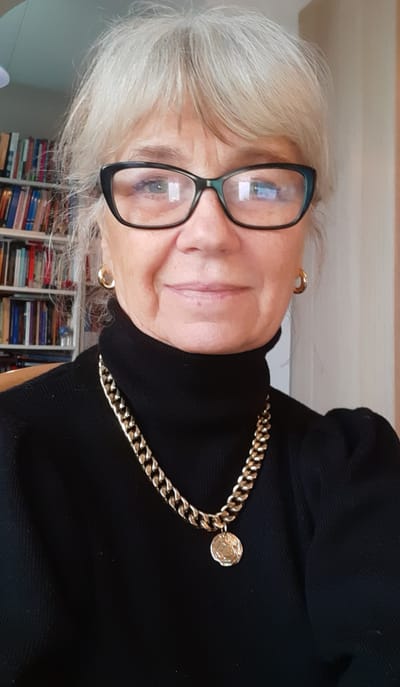
Felix Banda
Shifting and Multi-layered Dominant Language Constellations in Dynamic Multilingual Contexts: African Perspectives (2020) in J. Lo Bianco, L. Aronin (eds.), Dominant Language Constellations, Educational Linguistics 47, pp. 75-93. Springer https://doi.org/10.1007/978-3-030-52336-7_5
The chapter explores the notion of dominant language constellations (DLCs) in multilingual contexts of Zambia where 72 indigenous languages are spoken and English is used as the main language of education. I use data from migration and sociolinguistic literature, national census, online news media and call-in radio programmes to illustrate the multi-layered DLCs operating across individual/ household, community, regional and national boundaries. I argue that the different tiers of DLCs are a consequence of years of trans-regional and transnational migration as well as intense language and interethnic contact. The official language zoning, in which seven indigenous languages have been assigned regional language status for local government administration and early primary school education in ten provinces, and the colonial legacy of English as the language of national government business, secondary and higher education and socioeconomic mobility, have only added to the complexity and dynamism of DLCs. I show how the language practice of blending linguistic features from different languages results in discourses that reflects the DLCs operating in time and space. I conclude that the fluid multilingual contexts illustrated in this chapter suggest different DLCs operating simultaneously in and across individuals/households, communities and regions, and that the languages constituting these DLCs are not fixed leading to complex configurations and multiple strata of DLCs

Nayr Ibrahim
DLC artefacts as a research and pedagogical tool in teacher education
Nayr was aware of Larissa's work on DLCs, especially the DLC maps reflecting a constellation in the night sky with stars representing the different languages (Aronin, 2019b; Lo Bianco and Aronin 2020; Aronin and Vetter 2021). She first discovered 3D DLC modelling with playdough/plasticine and sticks at Larissa's session at the XIth International Conference on Third Language Acquisition and Multilingualism in Lisbon, 2018. This event is immortalized in a photo of Nayr sitting next to Richard Nightingale, holding her DLC model! This activity provided physical, tactile, and creative engagement with her language repertoire and DLC, and allowed for personal engagement with her multiple languages.
In increasingly multilingual and multicultural societies, teachers report a lack of knowledge and training in managing the ‘diverse diversities’ (Dervin, 2010) in classrooms today. The question arises how DLCs can be used in teacher education to not only develop knowledge of the complex phenomenon of multilingualism but also to uncover and make visible the language repertoires of future teachers. How does an explicit, creative focus on teachers’ language connections, relationships and identities, transform their perception of self as teachers of children or of a subject, such as English, to seeing themselves as multilingual individuals and teachers, and thus help them better engage with lived multilingualism?
Nayr decided to integrated these visualization methods into her teaching practice in Norway, where student teachers are encouraged to explore their multilingualism by creating an artefact that represents their full linguistic repertoire and naturally occurring DLC. This approach expands Aronin’s DLC modelling (both concrete and computer-assisted) into a creative, manual 2D or 3D task, where teachers are free to choose the layout or positioning, the materials, the colours, the shapes, and sizes. As Aronin and Moccozet (2021) state, external concrete representations ‘boost cognition by shortcutting analytic processes, saving internal memory, creating persistent referents and providing structures that can serve as a shareable object of thought’ (p. 5-6). Hence, concrete models of a personal DLC ‘serves both as a cognitive extension and a material symbol of one’s own sociolinguistic existence and the language skills that ensure this existence’ (ibid, p.7). Nayr’s study and forthcoming paper, ‘Visual and artefactual approaches in engaging teachers with multilingualism: creating DLCs in pre-service teacher education’ explores the affordances of DLCs for unveiling teachers’ multilingualism from a subjective, personal and critical perspective. It provides the teachers an agentic tool for unpacking their language biographies and for reflecting on their future practice.
Teachers created unique, subjective, artefactual narratives of their languages, in the form of a metaphorical object, representing their multilingualism from a biographical, educational and relational perspective. This process shone a light on a hidden multilingual identity that the student teachers were encouraged to engage with. Furthermore, from a quantitative perspective, this activity generated interesting insights into the DLCs that operate in Northern Norway: it highlighted a common Norwegian-English DLC with a third language which might be a heritage or other Scandinavian language.
See below some examples of teachers’ DLC artefacts:
Teachers were also asked to reflect on the process, their personal choices and how this activity might influence their future classroom practice by answering the following questions:
1. How did you organise your DLC and why did you choose the shape, materials, colours etc… to represent your languages?
2. How did creating a visual and manual (craft) representation of all your languages help you visualize your multilingualism and see yourself as a multilingual individual and multilingual teacher?
3. How do you think this will change the way you approach your students’ other languages in your English lessons?
4. How does this manual, visual, multimodal activity support and enhance creative teaching and ensure deep learning in the language classroom?
This generated comments, such as:
Creating my DLC made me realize that I know more languages than I think I do. I have always thought that I only knew one language, Norwegian, but through the process of creating my DLC I realized that I do know more languages than I thought.
By creating this atom to visualize my language repertoire I realized I know more than I thought I did. I was not aware that I knew 5 languages.
I have already seen myself as a multilingual individual but creating the visual representation of all my languages made me even more sure about it.
The activity invites pupils to express themselves visually and creatively, meaning that they could express feelings that are hard to describe in words.
Prof. Britta Hufeisen and her students
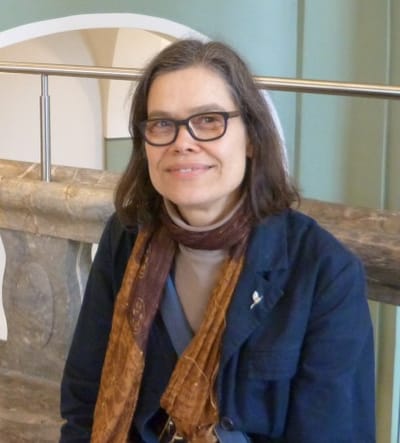
Director Language Resource Centre, Director Division of Linguistics - Multilingualism, Technische Universität Darmstadt
Siv Björklund and Mikaela Björklund
Contribution to DLC
Björklund and Björklund (2021) identified four contextual levels for the study of DLCs—individual, institutional, regional, and national. Their study concentrated on individual and organizational DLCs of Finnish/Swedish/English in one Finnish-medium and one Swedish-medium school, respectively. Although national curricula in Finland take linguistic diversity among the pupils into consideration, Björklund and Björklund suggest that uncovering layers of DLCs in organizations can reveal possible tensions between individual DLCs and institutional DLCs. The scholars believe that having an institutional DLC or DLCs would enable school or university leaders to provide appropriate affordances for languages in this institution.
theses, referats and worksheets
DLC Blog
Events
videos
This is a generic article you can use for adding article content / subjects on your website.
Read MoreThis is a generic article you can use for adding article content / subjects on your website.
Read MoreFile Manager
Sugrañes, Caterina
Currently in collaboration with Muiris O'Laoire and Larissa Aronin she works on
DLC LANGUAGES AWARENESS IN EARLY EDUCATIONAL SETTINGS FOR LANGUAGE LEARNING
GENERAL AIMS
To understand how teachers manage their own languages
To accompany teachers in reflecting upon how they manage their own languages
To explore how teachers teach languages to their own pupils
To make pupils aware of their own DLC through DLC creations
Panel
Workshop " From early childhood to adulthood: DLC materialities for continuity and transition in plurilingual education" Larissa Aronin & Nayr Ibrahim
12th international conference on third language acquisition and multilingualism. Zagreb, Croatia, 2022
Symposium " ENGAGING WITH DOMINANT LANGUAGE CONSTELLATIONS (DLCS) IN THE NORTH. Convenor: Nayr Ibrahim, Nord University, Norway
Evolving DLCs and identity transformation in multilingual transnational couples Anna Krulatz, NTNU, Norway Jennifer Duggan, USN, Norway
Mapping and visualising lower secondary school students’ multilingual practices and language beliefs Åsta Haukås, University of Bergen, Norway André Storto, University of Bergen, Norway Irina Tiurikova, University of Bergen, Norway
Visual and artefactual approaches in pre-service teacher education: DLCs as a pathway to multilingual classrooms Nayr Ibrahim, Nord University, Norway
Engaging Norwegian EAL teachers in reflective practice: A DLC approach Yaqiong Xu, NTNU, Norway
paper
DLC as a tool to document, describe and develop the multilingual state, tensions and potential in teacher practices in Finland Siv Björklund, Mikaela Björklund Åbo Akademi Univ
